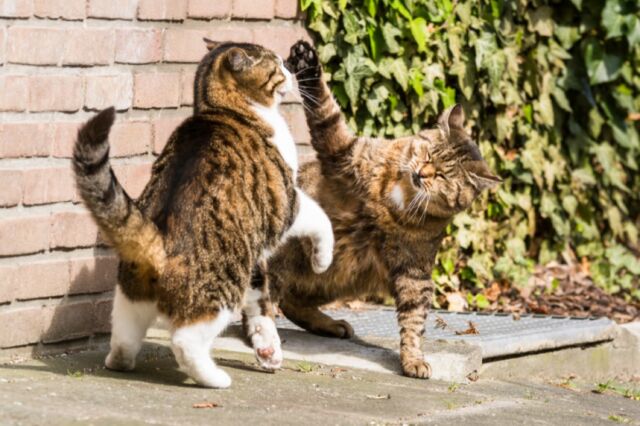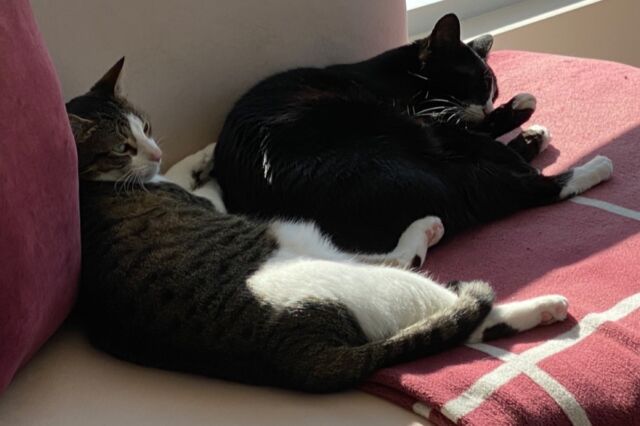

How to tell if your cats are playing or fighting—and whether it’s a problem
source link: https://arstechnica.com/science/2023/01/watching-youtube-cat-videos-for-science-are-those-cats-playing-or-fighting/
Go to the source link to view the article. You can view the picture content, updated content and better typesetting reading experience. If the link is broken, please click the button below to view the snapshot at that time.
Pfffftt! —
How to tell if your cats are playing or fighting—and whether it’s a problem
Reciprocity is the key. And occasional squabbles don't mean your cats hate each other.
Jennifer Ouellette - 1/31/2023, 9:03 PM

Anyone with more than one cat in the house knows that the occasional spat or outright cat fight is going to happen. But sometimes it can be tricky to determine whether cats are fighting or just playing rough, because the interaction could feature trademark behaviors of both, according to a recent paper published in the journal Scientific Reports. It's even more challenging to tell whether the fight is just a squabble or a sign that the cats simply can't get along, thereby forcing hard decisions about how to separate the cats—or even whether it's possible to keep the cat(s) in question.
In 2021, co-author Noema Gajdoš‑Kmecová, a veterinarian with the University of Veterinary Medicine and Pharmacy in Košice, Slovakia, and several colleagues published a review paper proposing the development of a common terminology and more of a "psychobiological" approach to the study of cat behavior—particularly when it comes to play behavior. Past studies had focused on a cat's play activity, such as whether it was playing with a toy or another cat. But such observation yields little insight into the function of such play and, by extension, a cat's motives or emotional state.
"When one cat treats another as an object or prey, such activity relates to the former cat seeking to learn about its own skills in relation to manipulating its physical environment (prey are not considered part of the complex social relationships and thus social environment of an individual)," they wrote in that paper. "However, when interaction between cats is reciprocal it may function to facilitate social learning and may be best described as mutual social play." Because such interactions are dynamic, they argued that any functional classification system must be flexible enough to account for such nuances.
AdvertisementThis new paper focuses on categorizing the telltale cat behaviors associated with playing and fighting to better distinguish between the two. First, the team browsed YouTube looking for videos showing cats playing, cats fighting, cats play-fighting, and similar search terms. They also advertised on Facebook, asking users to submit videos of their cats engaging in playing and/or fighting, or some combination thereof. The authors emphasize that this was merely a pilot study, so they did not collect any additional information about the cats featured in those videos or the humans who filmed them. However, owners who submitted videos were asked not to provoke their cats into engaging in play or antagonistic behavior for the camera.
After reviewing and culling the videos based on various exclusionary criteria, the authors deemed 105 videos showing 210 cats interacting suitable for further analysis. Behavior was broken into six broad categories that will be familiar to cat owners everywhere: inactive body postures (crouching, sitting, or standing); wrestling with "non-injurious" nips, rakes, and kicks; chasing, with one cat pursuing the other as if the other cat were prey, and/or a cat fleeing a pursuing cat; other interactions (grooming each other, belly presentation, sniffing, stalking, pouncing, and so forth); non-interactive activities like self-grooming, playing alone with a cat toy, drinking, or the "zoomies," for example; and vocalizations (growls, hisses, snarls, spits, yowls, and mews).
Once the analysis was complete, Gajdoš‑Kmecová et al. had identified three distinctive types of cat interactions: playful, "agonistic," and an intermediate category with a mix of behaviors from the other two categories—usually playful wrestling combined with vocalizations like growling and hissing, and/or one cat chasing another cat who fled. More than half of the cats (56.2 percent) engaged in playful interactions, compared to 28.6 percent whose interactions were clearly antagonistic. Another 15.2 percent engaged in mixed behavior.
AdvertisementThe authors noted that the playful category included an unusually high percentage of kittens engaged in wrestling behavior (a common kitten form of play). Wrestling is less common among antagonistic adult cats, since they tend to avoid direct contact. There were some adult cats in the study who engaged in prolonged wrestling that was deemed playful in nature, primarily because the behavior was reciprocal. The same was true for chasing behavior, which tended to fall under antagonistic behavior, unless there was a reciprocal element that suggested play—especially if there were no vocalizations or hostile ear or tail movements.
As for the intermediate category, Gajdoš‑Kmecová et al. suggest that this kind of mixed behavior is more likely indicative of a temporary disagreement, rather than a true breakdown in inter-cat relations. For instance, cats might start out engaged in a playful interaction, but then one wants to stop playing and the other doesn't. This is a common occurrence in our own household. Without human intervention, the situation can escalate into truly antagonistic behavior on the part of the cat (Ariel) who is disinclined to continue playing—growling, hissing, running away—with the other cat (Caliban) in hot pursuit, thinking this is all still part of their game. The worst squabbles can end with defensive paw swipes and result in scratched noses.
If these occasional squabbles are offset by mutual affectionate behavior, the overall longer-term relationship between the cats is probably still sound, per the authors—that is, if they still sleep close to each other, groom each other, and greet each other with ears erect, all signs they consider each other part of the same social group or "tribe." (Sometimes Ariel just needs her space.) "Our findings provide valuable practical evidence which can be used to help owners detect signs of intercat tension in its early stages," the authors concluded, which in turn could help "prevent major issues which might lead to the relinquishment... of one or both cats."
DOI: Scientific Reports, 2023. 10.1038/s41598-022-26121-1 (About DOIs).
Recommend
About Joyk
Aggregate valuable and interesting links.
Joyk means Joy of geeK

